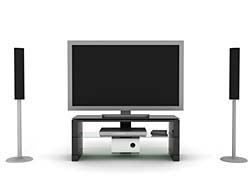Furthermore, many of the televisions tested for a report in Home Theater Magazine (May 2006) do not properly deinterlace signals, meaning that people who have paid a lot of money for HDTVs are not getting the full picture quality.
 Interlaced and Progressive Resolution
Interlaced and Progressive ResolutionHDTV has two types of resolution: interlaced and progressive. The type of resolution appears after the number indicating the lines of resolution. For example, 1080i means 1080 lines interlaced, whereas 1080p means progressive. Interlaced fields work by redrawing lines in a picture in sweeps. In the first sweep, every second line is drawn and then the remaining lines are drawn in the second sweep. In a 1080 broadcast signal, the 1,080 line frame is broken into two halves of lines. The first half, all the odd numbered lines, is sent during the first 1/60 of a second. The second half, the half containing the even numbered lines, is sent during the next 1/60 of a second. In a progressive scan all the lines are redrawn in each sweep.
Interlaced resolution is the number one HDTV broadcast resolution - most of the major television and cable networks use it. However, most digital displays are progressive, meaning that somewhere along the way the resolution must be changed from interlace to progressive. For a progressive television to show all 1,080 interlaced lines the processor in the television set must weave all lines together at once. Because the lines arrive in two sweeps, the HDTV processor must keep the first set of lines in its memory, receive the second set, and then combine them.
However, some processors simply take the first set of lines, 540 lines, and manufacture the missing information, the lines that have not yet arrived, in order to make up the picture. This method sometimes known as "bobbing," and it results in a lower-quality picture.
HDTVs Put To the Test
The article in Home Theater Magazine, titled "Are You Getting All the HDTV Resolution You Expected?" explains how HDTVs work and outlines the results of a study that found that of 54 HDTVs tested, over 48 percent did not properly process and deinterlace the 1080i signal. This means that people who purchased an HDTV that came in that 48 percent group are not actually getting the clear picture that they paid for.
In some cases, the manufacturers of televisions that did not pass the test did not ever claim that their televisions properly deinterlaced the 1080i. However, consumers may not be aware of what deinterlacing is or how it works - many probably just purchased their televisions believing that they were paying money for a good quality picture, not realizing that their television would not give them a high-quality picture.
Some 1080p televisions that failed the test (all models were from 2005):
Mitsubishi WD-62627
Samsung HL-R5668
Sharp LC45252
Of 54 HDTVs included in the study, 26 failed and 28 passed, although it must be noted that not all of the televisions that failed were 1080p. The study included HDTVs with 720 and 768 resolution.
